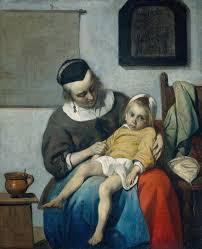
Prof. Dr. Saltmann, of Breslau, Communicates in an address a series of results from his experience with children, which may serve as indications in order to determine the disease of children as yet unable to talk. He says; we may conclude on whooping-cough when the child cries out violently, and screams with mouth wide open, while it presses its eyes shut. When it puts its hand to the mouth it is teething, or there is some other morbid process in the buccal cavity. In colic, the little legs are alternately drawn up and thrust down. The child lies with reddened face, bathed in perspiration and cries. Very sick children on the other had do not cry at all, as we see with those whose disease is of the lungs or the abdomen. The child then shows an unspeakably sorrowful, oppressed expression, as if it would cry out, but changed its mind. Characteristic and always different is the position of children in inflammation of the lungs and in inflammation of the pleura. In inflammation of lungs, the child always lies quietly on the back; but in inflammation of the pleura, it always lies on one side, and that the side affected, and when taken up they bend over toward the side affected. But in inflammation of the peritoneum the children always lie on the back, with the legs drawn together. On the face there is an expression of sorrowful oppression. In croup, which, as is well known, constricts the windpipe and shows itself in hunger for air and in dyspnoea, there is expressed in the face a dreadful, distressing anguish. All the muscles concerned in respiration, as well those of the neck as of the chest, are on a strain in order to convey air to the lungs. For this critical moment the celebrated Romberg has given the characteristic, physiognomical sign, in saying. “When the young practitioner is called at night to the beside of a croup patient, one look at the quiet nostrils and the diaphragm may suffice to enable him to comfort the watchers that there is no danger.” A similar anguish shows itself on the face of children sick in the heart, but these have more of a staring and immovable expression, with helpless eyes wide open, the children sit there, the muscles are no more sufficiently nourished by the blood and become relaxed and elongated; it is said then: “the children make a long face.” And no less strongly is the expression of the face of the mentally alienated distinct. The child’s expression is altogether strange. Staring, earnest, devout, peacefulness, telling of misfortune coming, is impressed on the face of those who have meningitis. The head is drawn backwards, the eyebrows are wrinkled in order to shade the eyes, and the lips are closely pressed together. This character of the devout and sublime has given rise to the saying: “The children are playing with the angels.” These harbingers of death bring about the mournful ending under convulsive attacks. Also in diseases of the intestines the study of the expression gives us some important points. In cholera infantum or summer-complaint, the expression of the child shows what is disagreeable and repugnant. The tongue is put out, there is much spitting and the like. In Inflammation of the bowels, the body of the little ones dries up like a mummy and gets an old look. The cushion of fat deposited under the skin disappears and the children come to have what is called a Voltaire face.”
These are some of the signs of nature in the speechless world of infants. The endangered life of the soul finds its expression in the visible types of the body. It is the language of the dumb, which suffering imprints upon the body, it is instructive to learn to interpret it, and the knowledge in instructive and valuable for all friends of nature and of the children’s world.




